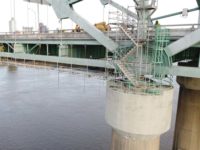A recent accident investigation and safety enforcement in the Midwest illustrates the problem of “entrapment”—that is, when an operator of an aerial work platform is crushed between the machine and a nearby obstruction. In many cases, experts say, entrapment occurs while the operator is repositioning the lift; in others, the operator leans onto the controls and sustains a crushing injury or even death.
An Indiana judge has now dismissed safety violations against Chicago-based Walsh Construction arising from the 2012 death of an employee working on the Milton-Madison Bridge in Indiana. Based on evidence provided by Walsh, the judge ruled that the worker was properly trained and supervised in operation of the boom lift that pinned him against an overhead piece of the bridge.
The accident occurred in April 2012 when Roger Cox, a 50-year-old union journeyman carpenter and welder hired by Walsh in 2011, was operating the JLG model 860SJ telescopic boom lift to perform weld bracing. The lift became pinned against the underside of the bridge, which spans the Ohio River between Indiana and Kentucky and Cox was found unresponsive in the lift basket. He died four days later.
Although sources close to the project speculated that Cox suffered a heart attack, causing him to collapse onto the controls, the Indiana Dept. of Labor’s investigation resulted in three safety violations against Walsh for failing to provide adequate operation and hazard training.
In contesting the violations before the Indiana Board of Safety Review in 2013, Walsh provided testimony from its site superintendent and safety manager that Cox had received, repeatedly, a variety of aerial-lift training during his eight months of employment. Cox also had been observed operating the lift properly under a variety of conditions and locations and was familiar with the work assigned to him on the day of the accident.
As part of its appeal, Walsh also presented evidence of some of the training Cox received. Neither the documentation nor the testimony specific to training were provided during the initial investigation. A Walsh project official declined to comment on the ruling. No civil action related to the accident has been filed.
The ruling, which dismisses $10,000 in fines that state safety officials levied against Walsh, comes as a growing number of U.S. contractors are requiring subcontractors and equipment rental companies to provide aerial lifts with additional anti-entrapment safety features.
“What happened with Walsh isn’t a one-off incident,” says Steve Smithgall, senior vice president of loss control for Balfour Beatty Construction. “Other incidents like this have occurred because most operators aren’t thinking about what could happen if they got pinned.”
Entrapment is a common fact pattern for lift accidents. In 2014, the non-profit International Powered Access Federation (IPAF) recorded 64 construction deaths involving lifts, 11 caused by entrapment. Sixteen entrapment deaths were reported to the association in 2013.
Genie Industries’ SkySiren and JLG’s SkyGuard are among the leading safety technologies—known as “secondary guarding” systems—available in the U.S. Each system uses a protective barrier linked to a pressure switch, which can disable the lift. SkySiren, which can be retrofitted on many different models, incorporates audio-visual warnings and a protective cage, while the JLG-specific SkyGuard automatically reverses the sequence of operations that led to the activation.
“It’s like an ‘undo’ button on your computer,” said Jeff Ford, JLG’s global product director, at last year’s Lift and Access Showcase in Las Vegas. So-called “primary guarding” systems, such as foot pedals, are not always enough to protect crushing injuries and are easily defeated through tampering, experts note.
Skanska USA Inc. and Balfour Beatty have mandated that, by January, all lifts on their projects must have secondary guarding systems, and other major contractors are considering it. Leading suppliers, such as United Rentals, Hertz, Sunbelt and Sunstate, have committed to retrofitting their fleets.
“The response from the rental companies has been very good,” observes Paul Haining, chief officer of environment, health and safety for Skanska USA. “We expect to have 100% compliance as of Jan. 1, 2016.” Smithgall says his company will use its regular jobsite-safety inspections for enforcement.
According to Jeff Stachowiak, director of safety training for Sunbelt Rentals Inc., retrofits can cost up to $2,500 per unit, which may translate into an extra monthly rental charge of $150 to $200.
And while IPAF generally recommends the use of secondary guarding devices, it cautions that preventing entrapment depends on a job-task analysis that includes selecting an appropriate guarding device.





Post a comment to this article
Report Abusive Comment